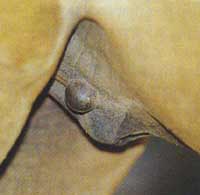Sarcoids
in Horses and Ponies - a form of equine skin cancer

Definition: Sarcoids in Horses are a benign
form of equine skin cancer thought to caused by a virus infection
which also causes skin diseases in cows.
Sarcoids should not be referred to as warts as they are not caused
by the papilloma
virus.
The growths are locally invasive in skin surrounding the sarcoid
but they do not spread to the horse's internal
organs as can occur with malignant tumours.
However some horses and ponies
do become severely affected by the condition.
Sarcoids can occur in all breeds, types and colours of horses
in all areas of the world.
Sarcoids can appear almost anywhere on the horse's
body. The most usual sites for sarcoids are areas of the horse
that have thin skin and/or with little or no
hair cover.
There are six different types of equine sarcoid:
Occult, Verrucose, Nodular, Fibroblastic, Mixed and Malevolent.
The verrucous or warty type
of sarcoid grows slowly and has a dry hardened, crusty or cauliflower
like appearance. It can be flat or pendunculated (stands up on
a stalk).
The fibrolastic form of sarcoid grows much faster
and usually occurs on the legs head or abdomen.
Sarcoids increase in number during the summer,
possibly spread by flies and insects, and increase in size during
the winter months.
Once a horse has developed one sarcoid
growth it is extremely likely that he will get more.
There are several methods of treatment for horse sarcoids -
Surgical Removal, Cryosurgery or freezing, Radiation, Homeopathy,
BCG Injection, laser surgery and chemotherapy are the most common.
Care must be taken with Homeopathic and natural
treatments as some substances such as Aloe Vera and
Tea Tree oil are contra-indicated and can be
dangerous.
The homeopathic remedy Thuja
has been reported as being a successful remedy for sarcoids where
other treatments have failed - especially for the waryt type.
Recommended use is 3 x 1m tablets twice a day for one week,
followed by a break of a week, then dosing for another week until
the growths disappear.
Thuja cream is another method of treatment and
can be applied every other day.
Silica is a homeopathic remedy recommended to
benefit the nodular type of sarcoid
Accidental injury, biopsy or surgical interference with a sarcoid
growth on a horse may aggravate the growth and cause agressive
regrowth.
Ideally a horse should be treated for sarcoids
at an early stage when the lesions are small and before they have
spread.
At the present time there is research being carried out on equine
sarcoids at universities worldwide.
|